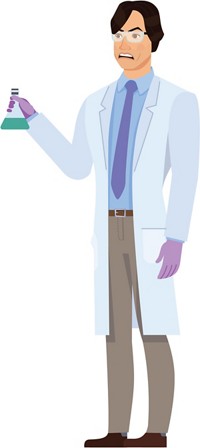Advertisement
Grab your lab coat. Let's get started
Welcome!
Welcome!
Create an account below to get 6 C&EN articles per month, receive newsletters and more - all free.
It seems this is your first time logging in online. Please enter the following information to continue.
As an ACS member you automatically get access to this site. All we need is few more details to create your reading experience.
Not you? Sign in with a different account.
Not you? Sign in with a different account.
ERROR 1
ERROR 1
ERROR 2
ERROR 2
ERROR 2
ERROR 2
ERROR 2
Password and Confirm password must match.
If you have an ACS member number, please enter it here so we can link this account to your membership. (optional)
ERROR 2
ACS values your privacy. By submitting your information, you are gaining access to C&EN and subscribing to our weekly newsletter. We use the information you provide to make your reading experience better, and we will never sell your data to third party members.
Employment
Bench & Cubicle
Will robots kill chemistry?
Chemjobber examines how computers and automation are likely to shift chemists’ jobs
by Chemjobber
April 9, 2019
| A version of this story appeared in
Volume 97, Issue 15

I’m just barely a midcareer professional, and tumult is one word that I can use to describe the economic shifts within chemistry that I’ve witnessed. In my short time in the industry, I’ve seen countless layoffs, the effects of off-shoring, and the dramatic swings in the business cycle that the Great Recession brought chemistry. Many jobs in the chemical enterprise have shifted to China and India, and mergers and acquisitions of companies have led to the shutdown of long-standing giants in the world of industrial chemistry. So it’s no surprise that chemists often discuss these perils to job security.
Are computers and automation a threat to chemistry jobs as well? What will happen as computers get smarter and smarter, and we get increasingly better at programming computers and unleashing their ability to perform complex calculations for chemistry? Rather than lose employment opportunities to lower-wage workers on the international stage, are we more likely to be replaced by a robot that doesn’t take 5 min breaks to tweet on its smartphone?
Economists categorize jobs as physical and nonphysical, cognitive and noncognitive. The modern laboratory chemist works with instruments that have automated routine physical and nonphysical tasks. A handful of people may still stand at gas chromatographs and inject samples one at a time, but for most chemists, those days are long past. The calculation and tabulations of the results of the gas chromatograph are a cognitive task, but it’s grindingly routine, so we’re happy for peak-picking and integration software that tells us whether we’ve made our product and in what purity. In this sense, automation has likely already shifted chemistry employment.
One place where we haven’t been purchasing equipment to automate routine or grinding tasks is in the synthetic laboratory. In most university and industrial laboratories, the majority of chemical experiments are still performed by humans. Many of these routine physical tasks remain difficult for robots to perform. As long as chemists can still manipulate chemicals, I think laboratory chemists are safe for the near term. However, trends in flow-based chemistry are advancing fast enough that I expect that, in 10 or 20 years, there will be standardized all-liquid reagent setups that allow syringe-based automated chemical reactor systems to do standard experimental setups in the laboratory 24 hours a day, 7 days a week.
And the nonroutine cognitive tasks within chemistry? This is where we chemists feel we add most of our value. We go to school to learn to think about chemistry and how chemicals interact and then apply that knowledge in the laboratory—surely computers can’t beat us there! I believe some recent developments are proving that wrong. In the past few years, software companies have built synthetic planning algorithms, training them with the chemical literature. You can input a structure into the computer, and it will find the best synthetic routes and propose potential reactions to try. Chematica, one of the contenders in this field, had laboratory chemists try its proposed reactions, and they were true to the software’s predictions. This is intimidating news to those who have prided themselves on their ability to analyze complex molecules and devise practical synthetic routes. What’s the point of going to school to learn retrosynthetic analysis if a computer can do it better?
A laboratory chemist’s nightmare would be to connect one of these computer programs to a robot that has access to the 1,000 most common reagents, allow it to run experiments, and then analyze the results. If this scenario became routine, bench chemists could become scarce. What is saving us from the fate of the fully automated chemistry machine? It is likely the cost and complexity of building and maintaining such machines. For the sake of laboratory chemists around the world, here’s hoping that human chemists are smart, flexible, and low cost enough to make these machines unattractive.
Will algorithms and robots take all our jobs? What would be left for us to do? The obvious answer, in my opinion, is the things that robots still can’t do.
Robots can’t taste, touch, see (not very well, anyway), or smell—these senses are multivariate and difficult to quantify quickly. The interface between pure chemistry and other fields (cell biology, the physical properties of polymers and other materials) may be complex enough that robots and algorithms will be 30 or 40 years behind as opposed to 10.
Personally, I am not afraid of more computers in chemistry, although perhaps I should be. Rather, I think people are still smarter and more creative than algorithms, and most importantly, better at working with other humans to prioritize and solve problems. Which problems should we use chemistry to solve? What are the right tools in chemistry to solve them? Whom do we include in making these decisions? How will the new chemistry that results interact with our bodies and our environment? These are questions that no computers and no algorithms can currently answer. Chemistry might someday be entirely automated, but it will still require chemists to remind fellow humans of the power of chemistry.
Chemjobberis an industrial chemist who blogs about the chemistry job market at chemjobber.blogspot.com. Find all his columns for C&EN and suggest future topics at cenm.ag/benchandcubicle.
Views expressed are those of the author and not necessarily those of C&EN or ACS.





Join the conversation
Contact the reporter
Submit a Letter to the Editor for publication
Engage with us on Twitter